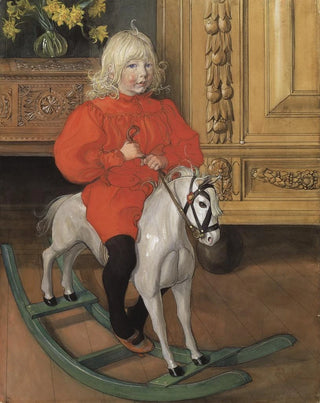Painting Portrait dialectal de Casimir Laurin - Carl Larsson | Art print


View from behind

Frame (optional)
In the fascinating world of art, some works stand out not only for their aesthetics but also for the story they convey. The art print Portrait dialectal of Casimir Laurin - Carl Larsson is a perfect example. This painting, which transcends a simple portrait, is part of an artistic tradition where the subject becomes a reflection of a specific era, culture, and unique personality. Carl Larsson, an iconic figure of Swedish art, manages to capture the very essence of his model, Casimir Laurin, while immersing us in a rich and evocative visual dialogue. Through this piece, the viewer is invited to explore not only Laurin's physiognomy but also the subtleties of his character and environment.
Style and uniqueness of the work
Carl Larsson's style is a masterful blend of realism and impressionist sensitivity, where each brushstroke seems to vibrate with emotion. In the dialectal art print of Casimir Laurin, the artist succeeds in creating an intimate atmosphere, almost tangible. The chosen colors, both soft and luminous, envelop the subject in a warm aura, while the meticulous details of Laurin's features reflect deep and respectful observation. Larsson does not merely reproduce an image; he conveys a story, a lived experience. Laurin's posture, his contemplative, almost melancholic gaze, evoke a psychological depth that invites the viewer to reflect on his thoughts and emotions. This portrait thus becomes a space of encounter between the artist, the model, and the audience—a true dialogue across time.
The artist and his influence
Carl Larsson, born in 1853, is often regarded as one of the pioneers of modern Swedish art. His career, marked by an incessant quest for authenticity and the beauty of everyday life, has profoundly influenced the Scandinavian artistic movement. Larsson distinguished himself through his commitment to representing family life, landscapes, and portraits with a unique sensitivity. His humanist approach to art, where each individual is celebrated in their singularity, paved the way for many contemporary artists. By choosing Cas

Matte finish

View from behind

Frame (optional)
In the fascinating world of art, some works stand out not only for their aesthetics but also for the story they convey. The art print Portrait dialectal of Casimir Laurin - Carl Larsson is a perfect example. This painting, which transcends a simple portrait, is part of an artistic tradition where the subject becomes a reflection of a specific era, culture, and unique personality. Carl Larsson, an iconic figure of Swedish art, manages to capture the very essence of his model, Casimir Laurin, while immersing us in a rich and evocative visual dialogue. Through this piece, the viewer is invited to explore not only Laurin's physiognomy but also the subtleties of his character and environment.
Style and uniqueness of the work
Carl Larsson's style is a masterful blend of realism and impressionist sensitivity, where each brushstroke seems to vibrate with emotion. In the dialectal art print of Casimir Laurin, the artist succeeds in creating an intimate atmosphere, almost tangible. The chosen colors, both soft and luminous, envelop the subject in a warm aura, while the meticulous details of Laurin's features reflect deep and respectful observation. Larsson does not merely reproduce an image; he conveys a story, a lived experience. Laurin's posture, his contemplative, almost melancholic gaze, evoke a psychological depth that invites the viewer to reflect on his thoughts and emotions. This portrait thus becomes a space of encounter between the artist, the model, and the audience—a true dialogue across time.
The artist and his influence
Carl Larsson, born in 1853, is often regarded as one of the pioneers of modern Swedish art. His career, marked by an incessant quest for authenticity and the beauty of everyday life, has profoundly influenced the Scandinavian artistic movement. Larsson distinguished himself through his commitment to representing family life, landscapes, and portraits with a unique sensitivity. His humanist approach to art, where each individual is celebrated in their singularity, paved the way for many contemporary artists. By choosing Cas
12,34 €






